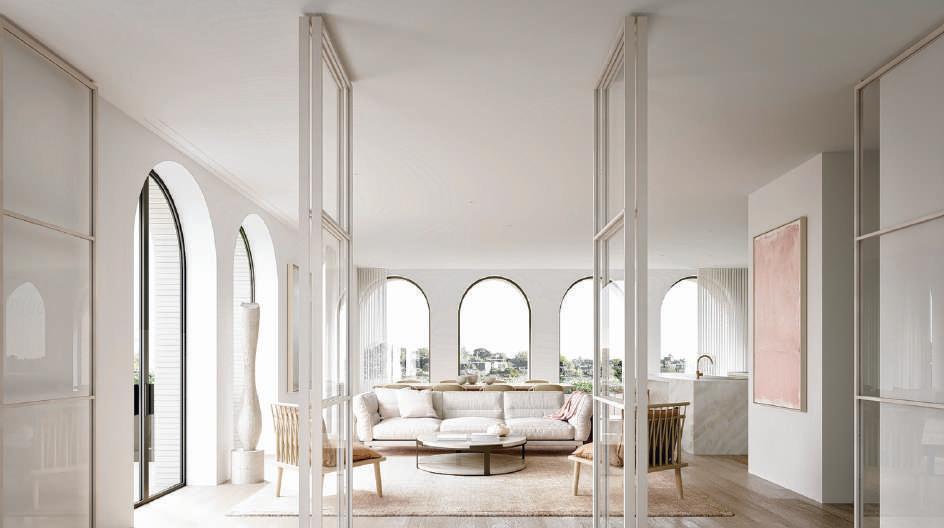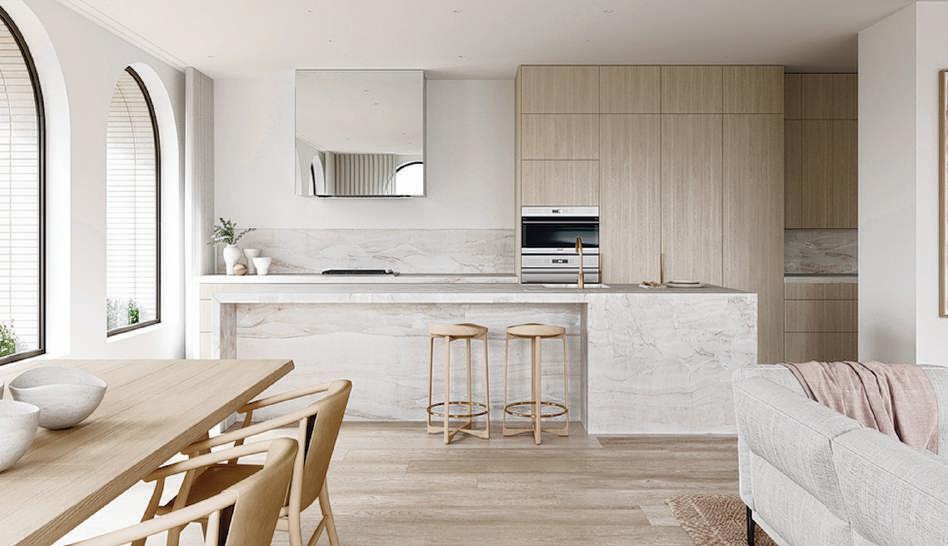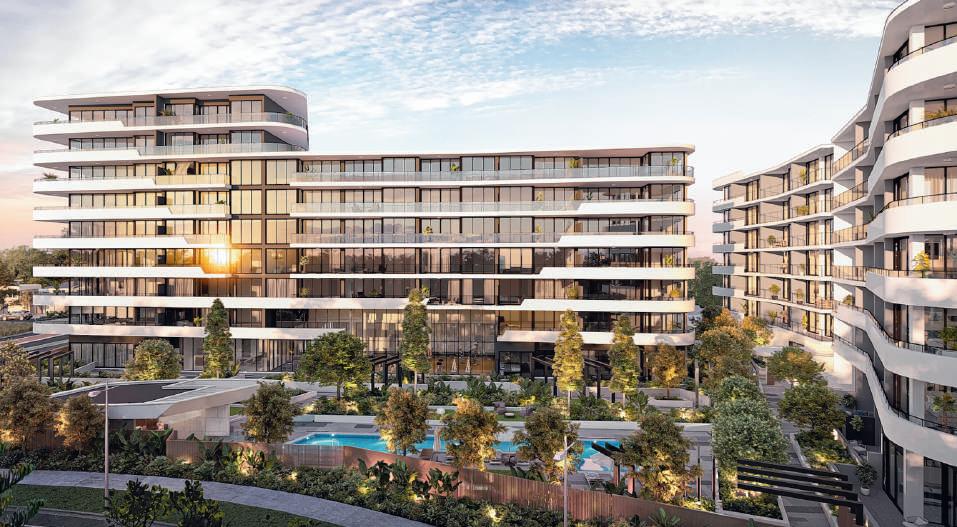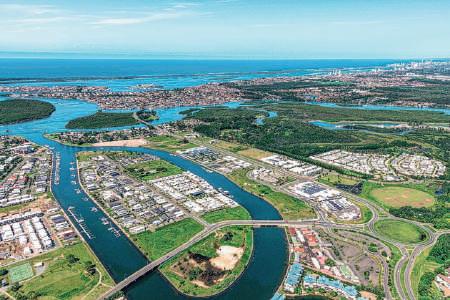
8 minute read
ROB MILLS
from Mansion March 2020
LISA ALLEN
A piece of the action Architect Rob Mills liked his own work so much he bought into his new luxe development
Advertisement
You have to admire architect Rob Mills’ attitude to his new Hampden luxe apartment development in the upmarket Melbourne suburb of Armadale. Like the Remington man, the award-winning architect liked the project so much he bought one of the larger units himself.
Mills, who divides his time between Sydney and Melbourne, forked out $4.6 million for the apartment in the yet-to-be-built block. Two other buyers, one a local from Armadale and another hailing from Sydney’s Woollahra, have paid $3 million apiece to buy into the nine-unit complex.
“The $4.6 million is all I can afford,” says Mills, adding that he would love to secure the $7 million penthouse in the complex for himself. He has designed and developed the nine-unit project at 2 Hampden Road, Armadale, with part of its attraction its proximity to the up-market suburb’s high-street precinct and its position in one of its most beautiful plane tree-lined streets. “It’s the equivalent of Sydney’s Woollahra; it’s got it all,” says Mills.
The architect based the design of Hampden on the six-level Fendi headquarters in Rome, commissioned by dictator Benito Mussolini and built in 1943, then renovated by local architect Marco Costanzi. He’s included electric chargers in the basement, as well as a landscape built into the facade so owners can have a small herb garden within reach of their kitchen.
“There’s a proper cook’s kitchen to promote cooking, which we think is important to a happy life,” says Mills. “It’s well considered and designed to last. We are trying to create a community by introducing buyers to each other.”
The seven-star rated building uses simple, pure choices of material. “Instead of being a plate glass wall, the exterior has a depth, the windows are brought in, there’s a lovely play of materials, textures and light.
“I thought it could be interesting to position it as a multiresidential mansion,” he says. Each apartment has three bedrooms, plus living, dining and kitchen. The penthouse also has a separate study. “The building is designed for the client. When I explain that to them at our first meeting, you can hear the sigh of relief.”
Mills says that at a time when apartment building standards are dropping, his firm is using old-fashioned procurement methods to get the best results.
Construction on Hampden starts in July, with completion slated for July 2022. Apartment prices range from $3 million to $7 million.
Meanwhile in Sydney, Rob Mills Architects is renovating one of Bronte’s oldest homes, which Mills says is quite a famous estate, refurbished back in the 1980s.
“We are removing a lot of that work and returning it to its Victorian grandeur, and adding self-contained quarters at the back,” he says. “We have the most beautiful properties in Mosman, Bellevue Hill, Vaucluse and Point Piper – most of them are brand new designs.”

From top: Living area, dining room and kitchen of architect Rob Mills’ $4.6 million apartment in Hampden, the luxury project he is developing in Armadale, Melbourne


MICHELLE SINGER
Hope springs eternal
Golfing, boating and shopping facilities make this Gold Coast enclave a winner with retirees and investors alike

Clockwise from top left, No 1 Grant Avenue’s exterior; Hope Island aerial; George Mastrocostas from Aniko Group

The golfing and boating mecca of Hope Island, the aspirational and prestigious integrated north Gold Coast resort, is undergoing a renaissance, underpinned by billions of dollars’ worth of luxury residential developments and major infrastructure projects.
An exclusive enclave for retirees and overseas investors during the 1980s and 90s, the 360ha resort has faced myriad hurdles including the collapse of two previous owners, Shinko Australia in 1999 and Gold Coast developer John Fish in 2010. After development stopped, infrastructure failed to materialise and defaults hit record levels a decade ago, the $1bn project has reinvented its image and is delivering on its luxury lifestyle offering. Ray White Surfers Paradise chief executive Andrew Bell says the make-up of the area has changed to meet the market and buyer demographic, as a new generation of developers and landowners release realistically priced product.
“No one wants those big homes any more,” says Bell. “If you look at the biggest growth area it’s the terrace home. It caters to a very sophisticated local market and interstate buyer as well.
“Last year there was an incredible sense of maturity starting to shine through into that marketplace. It has become an area of great strength and completeness in its own right. There’s entertainment, restaurants and shopping — the area has everything. The only thing that’s missing is greater awareness.”
An estimated $1.3 billion in residential developments is under way in the area, as well as $4.3bn worth of infrastructure, putting Hope Island at the centre of one of Australia’s hottest growth corridors, according to a report by property consultants Urbis. Among the biggest residential projects is The Gallery, a $35m land release by GH Properties; the $73m final stage of Frasers Property Group’s Cova development; Anchorage Apartments, a $100m luxury masterplanned waterfront development; and Lyra, a $90m townhouse and land development.
The biggest project still to come is Serenity Cove, a masterplanned community purchased by Brisbane-based developers Keylin Group for $50m. Due to settle this month, it is the final developable parcel of land within Hope Island.
Projects such as this herald a wave of new wealth, attracting buyers in their 40s and 50s from cities such as Sydney who appreciate the manicured public areas, 24-hour security and laidback lifestyle, along with the access to the Gold Coast Broadwater, and proximity to Brisbane and Gold Coast airports.
Developer George Mastrocostas, 39, represents Hope Island’s next generation as his company, Aniko Group, works its way through a project pipeline of $1bn, spread throughout the Gold Coast. When he was in his late 20s Mastrocostas was all too aware of Hope Island being dubbed “a basket case” that was “best to be avoided and forgotten about”. Eventually he saw it as a sleeper suburb with potential, aggressively negotiating on three super lots in 2015 and taking a gamble that the long-awaited Hope Island Town Centre would be delivered. Completed in December 2018, it saves residents a 40-minute round trip to the previously closest shopping centre and has been credited as one of the biggest catalysts for the area’s transformation.
“I think the risk has eventually paid off,” Mastrocostas says. “I still think of Hope Island as one of Australia’s premier lifestyle resorts and we saw an opportunity there with little risk once that Hope Island Marketplace was completed.”
During the past seven years, Hope Island’s rising house prices have made it one of Queensland’s best performers. They increased from $474,775 in 2012 to $760,654 last year — an improvement of almost 60 per cent, according to CoreLogic RPData figures.
The enclave has been long associated with prestige and at times opulent homes, such as the high-profile canal-front house Sails at 2585 Gracemere Court North, which was first listed for $25m and most recently sold in 2016 for $11m.
Aniko Group’s $140m No 1 Grant Avenue project caters for a different buyer altogether. Priced from $369,000 to $665,000, it still embodies Hope Island’s luxury image, Mastrocostas says, thanks to amenities such as a health club designed by fitness guru Michelle Bridges and pet-wash facilities for the 80 per cent of residents who are expected to own a pet.
“I’m surprised how many people want to upsize their lifestyle and downsize their house,” says Mastrocostas, having sold about 60 per cent of the 210 apartments in stage one. “We’re seeing plenty of buyers selling out of their multi-million dollar mansions and buying in No 1 Grant Avenue.
“A project like this right in the heart of Hope Island would normally not be accessible to these buyers without sacrificing design, quality and amenity.”
Tony Hymus, sales and marketing consultant for GH Australia’s boutique 46-lot subdivision The Gallery, has worked on and off within Hope Island for the past two decades. Prices at what is its first residential land release within a decade start from $545,000 for a 608sq m lot and go up to $1m for 873sq m of land fronting Links Hope Island Golf course.
“The reception from the community has been great,” Hymus says. “We’ve got 22 unconditional contracts to date. That success surprised me a bit, especially as the interest has been spread over several different demographics. It’s changing the scope of the resident, creating a diverse community with younger families, downsizers, expats and overseas investors.”
A refurbished clubhouse and additional amenities such as a gym are in the pipeline too and are likely to add even more appeal, Hymus says.
“Not having much stock available puts us in a pretty good position and more specifically puts buyers in a good position. The civil construction is under way and the reality is you won’t be stepping on this land until March. If you do the homework and look at where the market is going, with such a shortage of property I can’t see how you can go wrong. Apart from being a great place to live, it’s a very safe investment.”










